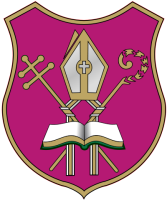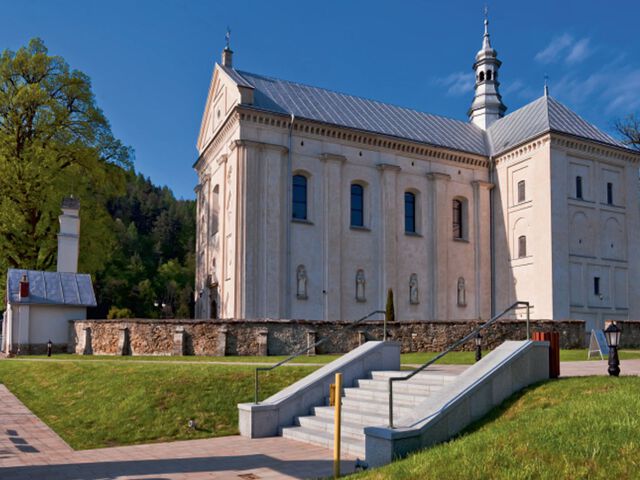



The parish has existed since 1330. The original wooden church stood at Piłsudskiego Street. The present church is dedicated to St. Józefa (former NPM) was built in the years 1676-1728. Consecrated in 1749. Renovated many times, incl. in 1803, 1950 and 1965-1966. Outdoor restaurant of the church 1986. Baroque stone and brick, plastered, covered with sheet metal. The roof has one ridge, single-nave with an elongated four-span nave and a higher chancel closed in a semicircle, with a new annex from the north (now sacristy) and a side chapel from the south (former sacristy). With a second floor added in 1803. The interior is covered with cross vaults on girt, flowing onto the wall pillars, supporting a prominent, breaking cornice. Semicircular rainbow arc. Above the vaults in the attic storey there are shooting positions with looping key niches, talking about the originally defensive function of the church.
Outside, the walls are divided by pilaster divisions, topped with a circling console. From the front, the façade is topped with a triangular abutment. Saddle roof. On it a prominent, baroque turret with a turret with a lantern and a spherical cupola. Inside, there are painted decorations, emphasizing architectural and figural elements by A. Marczyński - 1965. The main classicist altar / early Nineteenth century /, in it a sculpture of the Mother of God with Child - a Gothic - from around 1470, and a retractable Image of St. Joseph, baroque-18th century. On the altar of the Tabernacle in the shape of a temple with a relief of the Annunciation - Renaissance - from around 1600.
In Antepedium kurdyban / pattern-embossed leather with gilding / three pieces - 18th century. There are two side-early baroque altars in the presbytery. In one: the image of the death of St. Józefa - early Eighteenth century, in the second image of St. John the Baptist in the desert - early 18th century. In the nave: the first pair of the altar - late Baroque with pictures: on the right - St. Sebastian, on the left - the Heart of Jesus. The second pair of altars: Rococo with paintings: St. Anthony and Our Lady of the Rosary. The third pair of late baroque altars with paintings: the Crucifixion of Jesus and St. Teresa of Avila. Late baroque baptismal font with a backrest in the form of a retable with the image of the Baptism of Jesus in Jordan - 18th century. Baroque pulpit - end of the 17th century. In the rainbow there is a beam with a decorative pattern with a group of the Crucifixion on the globe (17th-18th century).
Sculpture : St. Jadwiga and St. Otylia-gothic-from around 1470
Images :
1. Mother of God with the Child / votive-1708 /;
2. Washing the feet of Jesus by Maria Magadalena - 18th century;
3. St. Anna Samotorzeć- 18th-19th century.
Portraits of : Bishop A. Trzebicki and Bishop A. Załuski - both probably from the 18th century.
People's crucifix from the 18th century. Classicist Pacific - early XIX century. Wooden hostriarka from 1705.
A free-standing brick belfry, probably from 1803, in the shape of an arcade with bells, topped with a triangular abutment. Two bells of an undetermined cast.
The church is surrounded by a stone wall - in its perimeter there is a chapel from the beginning of the 19th century. Inside the chapel there is a sculpture of Christ at the pillar - baroque - folk - 18th - 19th century.
In the side chapel of the Epitaph of late Prelate Eugeniusz Piech - performed by prof. Academy of Fine Arts in Krakow - Czesław Dźwigaj from Krakow.
HISTORY
It was built in the years 1676-1728 in the baroque style. The founders of the temple were bishop P. Gembicki and bishop A. Trzebnicki. It was consecrated in 1749 by bishop A. Załuski. In 1803, during the renovation, the northern sacristy was added. The church was originally built on a cross plan, but the floods in the 18th and 19th centuries destroyed the right and left wings. Built of stone and brick and then plastered, it once served as a defensive point (as evidenced by the shooting posts located above the sacristy). However, there are no documents describing any specific case of an attack on the church. The outer walls are divided by pilasters, above which there is a cantilever cornice. The outer façade is crowned with a triangular abutment. The gable roofs are decorated with a baroque turret with a spire, a lantern and a spherical cupola. The temple has a single nave with a four-span nave, which ends with a narrower chancel closed in a semicircle. Inside, the cross vaults on the buttresses turn into wall pillars ended with a cornice. In front of the presbytery, there is a beam with the image of Christ on the cross, and on the walls there is a polychrome by A. Marczyński from 1965. The Classicist altar is decorated with a Gothic figure of the Mother of God and Child by Jakub from Nowy Sącz from 1470, a Baroque painting of St. Joseph, and above all the Renaissance Tabernacle which is a miniature temple with a relief "Annunciation" from 1600. Also worth seeing are the paintings on the side altars: Christ, St. Peter and Paul from 1640, St. John the Baptist (18th century), Crucifixion (18th century), St. Teresa of Avila (19th century), St. Sebastian (17th century), the Heart of Jesus (baroque painting). The baroque baptismal font with the image of baptism in Jordan (XVHI century), the pulpit from the beginning of the 18th century, richly decorated with acanthus leaves and statues of saints, and embossed in leather and gilded curds in the main altar, as well as in the two side altars, are also extremely valuable. Among the smaller monuments, the Gothic sculptures of St. Jadwiga and St. Otylia from 1470, the work of Jakub from Nowy Sącz, a folk crucifix from the 18th century, a classicist pacific from the 19th century, a wooden hostess from 1705.
It is also worth seeing the paintings of bishops A. Trzebnicki and A. Załuski from the 18th century, the votive painting of the Virgin Mary from 1708 by J. Madycki, "Washing the feet of Christ by Maria Magdalena" and the painting "Saint Anna Samotrzecia" from the turn of the 18th and 19th centuries century.
The church belfry from 1803 is located in the perimeter of the 17th-century wall. It has the shape of an arcade for hanging bells. The chapel from the turn of the 18th and 19th centuries is located near the bell tower in the wall surrounding the church. Inside, there is a statue of Christ at a pillar in the baroque-folk style and four crosses on the walls.
The figure of St. John of Nepomuk from around 1876 is a cast-iron statue placed on a stone plinth in the church courtyard.
The former rectory from the first half of the 19th century is a brick building with a hipped roof covered with sheet metal. A porch on two pillars is visible from the front.
An old well has been preserved in the cellars, and a barn and a shed in the farmyard.
Kościelna 62, 33-370 Muszyna
Lack
750 m
Używamy plików cookies aby zwiększyć funkcjonalnośc strony oraz zbierać statystyki odwiedzin witryny.
Zaakceptuj i kontynuuj.